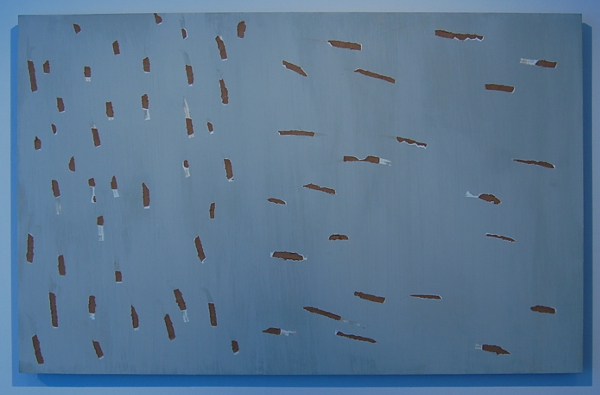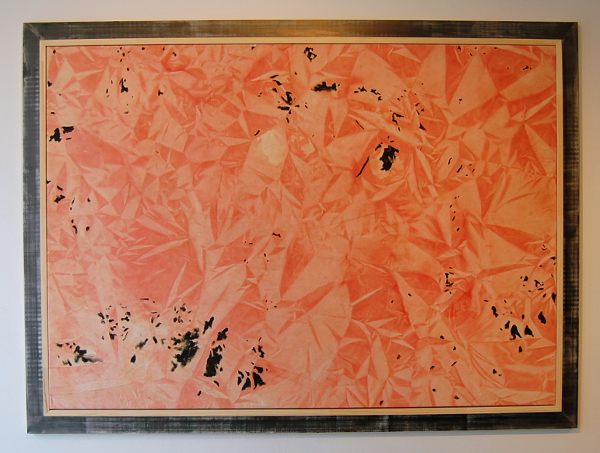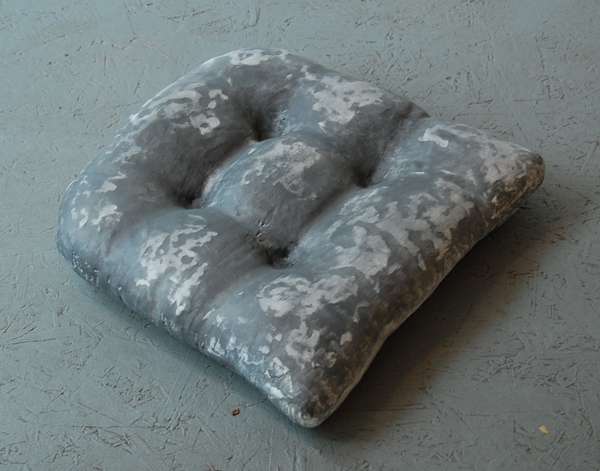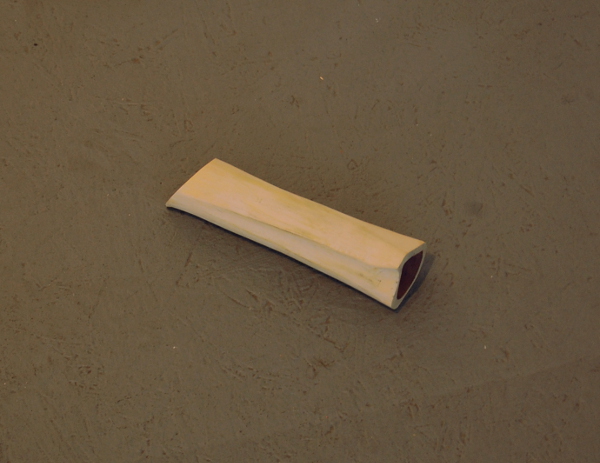
Domesticated dogs and humans with Ryan McCartney at Rebekah Templeton
Each of the objects placed into the small space of Rebekah Templeton Contemporary Art pines for the familiar and the accessible, but somewhere along the way, these creations lose their way. Artist Ryan McCartney impresses the weight of the banal upon the viewer with simplified process pieces that excel at innuendo without revealing their true nature. For a show entitled “dog and wolf,” the space is surprisingly devoid of life, although the remnants hint at both the order and the messiness of human beings and their canine companions.
After eons of evolution and cooperation, dogs have become as domesticated as their bipedal counterparts, residing in human abodes, resting on furniture, and chewing on precisely sliced, hollow bones. Despite all of this, instinct persists beneath the layers of conditioning, and the wild wolf mind lives on amidst the plush surroundings and easy meals.
One plank of wood painted a steely shade of flat gray is named “cuts and scrapes” for the deliberate pattern of slices and chiseled chunks removed from its otherwise consistent surface. Like a dog destroying a sofa while its humans are at work, we find the primal act of physical destruction to be somewhat liberating. McCartney applies a plain coat of paint with only the intention of then gouging it apart. The only difference between his act and that of a bored animal is presumably the contemplation behind each mark. While the dog’s breaking with order is considered merely a messy hassle, under the artist’s hand it can become a symbol. So where exactly should we draw the line between image-making and physical action?
Ryan McCartney, “no sweat (sheet set 3).”
In other pieces, the line is more defined. For “no sweat (sheet set 3),” the large, textured canvas does actually read like a painting, and not only because of its frame. The texture of crumpled paper or disheveled bedsheets seems almost unintentional, but the specter of intention is undeniable. Even the seemingly random assortments of dark splotches are evenly distributed, and it provides an additive alternative to the subtractive scratches in the neighboring work.
Exactly how much do we play a part in the organization we have imposed upon ourselves? How much do we act out against our boundaries? In what ways are humans still ‘wolves’ in their own right? These are the questions McCartney seems to hide just below the surface, while form and process dominate the foreground.
Ryan McCartney, “austerities.”
Looking around, we find other images that represent urbane furnishings and soon-to-be-gnarled chew toys. A cushion made of plaster called “austerities” reminds us that we enjoy a relative comfort that our not-so-distant ancestors could scarcely have dreamed of. Across the gallery, another piece seated on the floor depicts a bone carved from wood and then painted white. The marrow-filled bones our wild counterparts once gnawed on have been replaced with empty, finely manicured ‘toys’ extracted from grisly sources. Animal parts become commodities as much as the animals themselves, many of whom are bred for their agreeable characteristics. When exactly does the semblance of control break down, however? When our pet dog bites us or lush homes fail to provide us with peace of mind, we are reminded of how tenuous our mastery over the world truly is.
Ryan McCartney, “all teeth.”
Although seemingly mundane, the artworks in “dog and wolf” provide us with the means to explore our past and present outside of all the cultural baggage. Both human and canine alike straddle the border between civility and ferocity, and in the unlikeliest of places and times, we find language and symbols to be inflated beyond their worth. Rebekah Templeton will be showcasing Ryan McCartney’s “dog and wolf” through June 21.
Rebekah Templeton Contemporary Art is located at 173 Girard Ave., Philadelphia; [email protected]; rebekahtempleton.com.
Recent Content
-
Artsarticle ·
-
Artsarticle ·
-
Artsarticle ·



